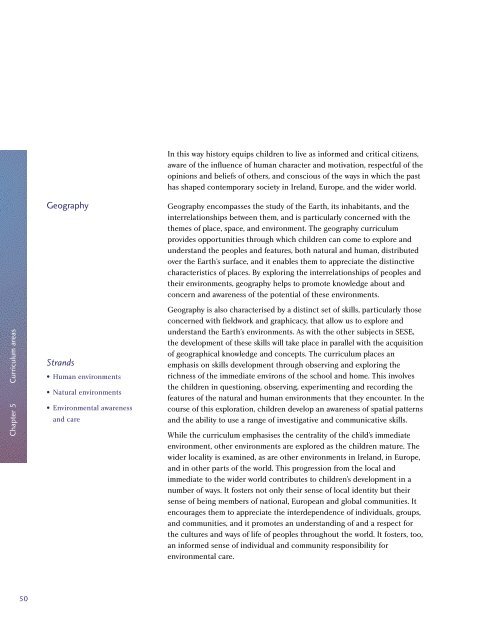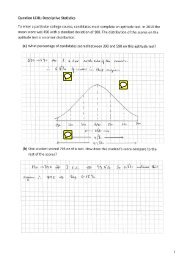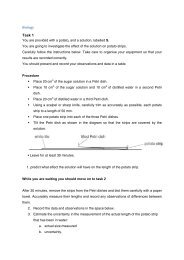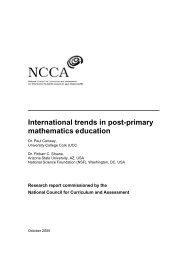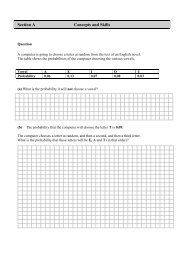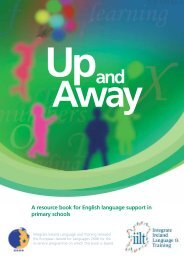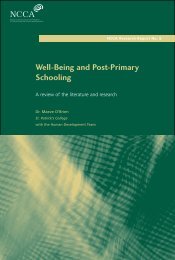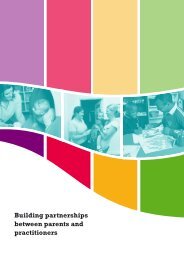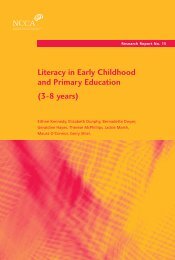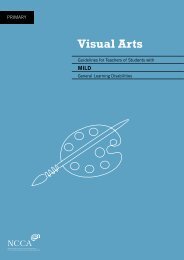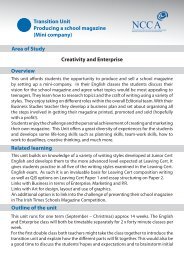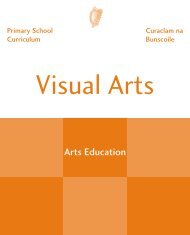Primary School Curriculum Curaclam na Bunscoile - NCCA
Primary School Curriculum Curaclam na Bunscoile - NCCA
Primary School Curriculum Curaclam na Bunscoile - NCCA
Create successful ePaper yourself
Turn your PDF publications into a flip-book with our unique Google optimized e-Paper software.
Chapter 5 <strong>Curriculum</strong> areas<br />
50<br />
Geography<br />
Strands<br />
• Human environments<br />
• Natural environments<br />
• Environmental awareness<br />
and care<br />
In this way history equips children to live as informed and critical citizens,<br />
aware of the influence of human character and motivation, respectful of the<br />
opinions and beliefs of others, and conscious of the ways in which the past<br />
has shaped contemporary society in Ireland, Europe, and the wider world.<br />
Geography encompasses the study of the Earth, its inhabitants, and the<br />
interrelationships between them, and is particularly concerned with the<br />
themes of place, space, and environment. The geography curriculum<br />
provides opportunities through which children can come to explore and<br />
understand the peoples and features, both <strong>na</strong>tural and human, distributed<br />
over the Earth’s surface, and it e<strong>na</strong>bles them to appreciate the distinctive<br />
characteristics of places. By exploring the interrelationships of peoples and<br />
their environments, geography helps to promote knowledge about and<br />
concern and awareness of the potential of these environments.<br />
Geography is also characterised by a distinct set of skills, particularly those<br />
concerned with fieldwork and graphicacy, that allow us to explore and<br />
understand the Earth’s environments. As with the other subjects in SESE,<br />
the development of these skills will take place in parallel with the acquisition<br />
of geographical knowledge and concepts. The curriculum places an<br />
emphasis on skills development through observing and exploring the<br />
richness of the immediate environs of the school and home. This involves<br />
the children in questioning, observing, experimenting and recording the<br />
features of the <strong>na</strong>tural and human environments that they encounter. In the<br />
course of this exploration, children develop an awareness of spatial patterns<br />
and the ability to use a range of investigative and communicative skills.<br />
While the curriculum emphasises the centrality of the child’s immediate<br />
environment, other environments are explored as the children mature. The<br />
wider locality is examined, as are other environments in Ireland, in Europe,<br />
and in other parts of the world. This progression from the local and<br />
immediate to the wider world contributes to children’s development in a<br />
number of ways. It fosters not only their sense of local identity but their<br />
sense of being members of <strong>na</strong>tio<strong>na</strong>l, European and global communities. It<br />
encourages them to appreciate the interdependence of individuals, groups,<br />
and communities, and it promotes an understanding of and a respect for<br />
the cultures and ways of life of peoples throughout the world. It fosters, too,<br />
an informed sense of individual and community responsibility for<br />
environmental care.


